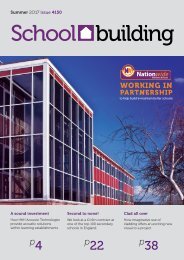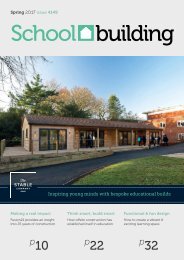SB 4156 32pp WEB
Create successful ePaper yourself
Turn your PDF publications into a flip-book with our unique Google optimized e-Paper software.
Case Study<br />
The increasingly important role of offsite<br />
in education<br />
With an unprecedented shortage of schools in this country, it is clear to see that despite what doomsayers print, the UK has a<br />
voracious appetite for buildings that isn’t going away any time soon. How we choose to deliver these buildings is ultimately up<br />
to us. The real question is this; can we quickly build enough to meet an ever increasing demand? Only if we change our<br />
methods. School Building Magazine Editor Joe Bradbury discusses:<br />
Our industry needs to change. To do<br />
this, we must cast a critical eye<br />
over our own behaviour and<br />
acknowledge our shortcomings; something<br />
many feel understandably hesitant to do.<br />
The bad news is that the UK construction<br />
industry is currently responsible for 45% of<br />
total UK carbon emissions, 32% of all landfill<br />
waste and is responsible for more water<br />
pollution incidents than any other industry.<br />
Are these really the lessons we want to teach<br />
our children, who cut their teeth in buildings<br />
that serve as a physical embodiment of this<br />
harsh reality? Thankfully, we have the<br />
knowledge, skills and technology to facilitate<br />
real change in the world, when we put our<br />
minds to it… and we really need to!<br />
The scale of the challenge<br />
There are currently 32,113 schools and 142<br />
universities in the UK. Studies suggest that<br />
over two-thirds of these buildings are<br />
considered "not fit for purpose" by their head<br />
teachers and deans, who cite leaks, asbestos,<br />
faulty heating and damp as common<br />
problems.<br />
Overall pupil numbers are also expected to<br />
increase by 654,000 to around 8.1m by 2026.<br />
In secondary schools alone, the overall<br />
population is projected to reach around 3.3m<br />
in 2026, a 19.1% increase of around 534,000<br />
more pupils.<br />
In 2016, procurement specialists Scape Group<br />
estimated that in order to meet this<br />
increasing demand, we needed to have been<br />
building 2,000 new schools each year in the<br />
run up to 2020. Where we are with this is<br />
anyone’s guess, but what is clear from<br />
assessing the figures above is the vastness of<br />
the challenge. It will require dedication and a<br />
collaborative approach to overcome. Only by<br />
pulling together as an industry and trying<br />
new things can we deliver the new learning<br />
environments so desperately needed within<br />
any meaningful timeframe.<br />
The answer is offsite<br />
Considering that time is of the essence, allow<br />
me to remind you that an offsite solution can<br />
be delivered in a matter of weeks, with<br />
minimal onsite disturbance. This makes it<br />
perfect for schools, because work can be<br />
carried out in between terms to minimise<br />
disruption for students and pupils. Why turn<br />
your place of learning into a building site for<br />
months at a time, temporarily attempting to<br />
teach from temporary, leaky, cold structures?<br />
This is not conducive to learning and<br />
interrupts student routine at a time when<br />
they need to be focussed on their studies.<br />
Offsite construction is far less energy<br />
intensive than traditional building methods,<br />
meaning it is better for the environment; a<br />
message that must be taught to the next<br />
generation!<br />
The carbon footprint left by the many<br />
construction vehicles and machinery on the<br />
site of a traditional construction project alone
















